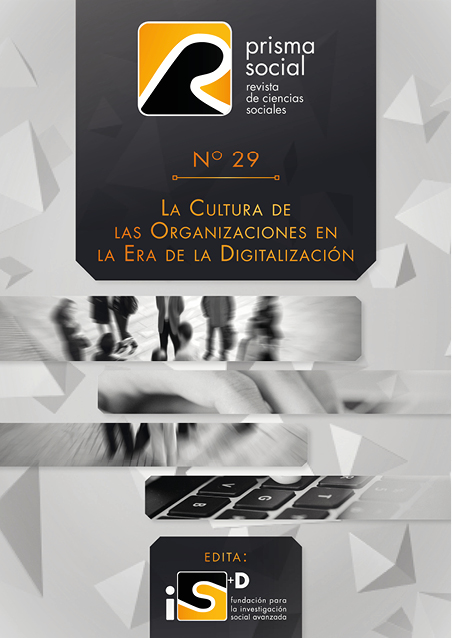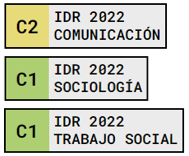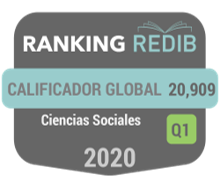Mental health images on the Internet: A Facebook and digital media content analysis in Spanish
Palabras clave:
Mental health, Internet, Facebook, digital mediaResumen
Este trabajo analiza la imagen de la salud mental difundida a través de medios digitales y redes sociales, en español, tras la aprobación de la resolución 32/18 del Consejo de Derechos Humanos, sobre salud mental y derechos humanos Para ello, se realizó un análisis estandarizado del contenido de una muestra de 370 noticias publicadas durante un período de seis meses, entre agosto de 2016 y enero de 2017, para determinar si el tratamiento periodístico de las noticias era positivo, negativo, equidistante o institucional. Asimismo, se estudiaron 352 páginas de Facebook, con los mismos criterios de análisis. Entre los resultados, destaca que sólo el 53% (n = 196) de los artículos abordaron directamente la salud mental. De ellos, el 40% (n = 79) lo trató positivamente, mientras que el 26% (n = 50), negativamente. Además, un alto porcentaje de artículos (18%, n=35) trataba la salud mental metafóricamente, lo que contribuye tambiéna la estigmatización de las enfermedades mentales. El análisis de las páginas de Facebook mostró una baja proporción del tratamiento positivo de la salud mental (5%, n = 18), y en el 61% de la muestra estudiada (n = 215) el contenido no tenía nada que ver con la salud mental.
Descargas
Citas
Aragonès, E., López-Muntaner, J., Ceruelo, S., & Basora, J. (2014). Reinforcing stigmatization: coverage of mental illness in Spanish newspapers. Journal of Health Communication, 19(11), 1248-1258.
Ayers, S. L., & Kronenfeld, J. J. (2007). Chronic illness and health-seeking information on the Internet. Health: 11(3), 327-347.
Barry, C. T., Sidoti, C. L., Briggs, S. M., Reiter, S. R., & Lindsey, R. A. (2017). Adolescent social media use and mental health from adolescent and parent perspectives. Journal of Adolescence, 61, 1-11.
Berger, M., Wagner, T. H., & Baker, L. C. (2005). Internet use and stigmatized illness. Social Science & Medicine, 61(8), 1821-1827.
Berryman, C., Ferguson, C. J., & Negy, C. (2017). Social media use and mental health among young adults. Psychiatric Quarterly, 1-8.
Bowen, M. L. (2016). Stigma: Content analysis of the representation of people with personality disorder in the UK popular press, 2001-2012. International Journal of Mental Health Nursing, 25(6), 598-605.
Brailovskaia, J., & Margraf, J. (2018). What does media use reveal about personality and mental health? An exploratory investigation among German students. PloS one, 13(1), e0191810.
Brodie, M., Flournoy, R. E., Altman, D. E., Blendon, R. J., Benson, J. M., & Rosenbaum, M. D. (2000). Health information, the Internet, and the digital divide. Health Affairs, 19(6), 255-265
Brusilovskiy, E., Townley, G., Snethen, G., & Salzer, M. S. (2016). Social media use, community participation and psychological well-being among individuals with serious mental illnesses. Computers in Human Behavior, 65, 232-240.
Cabrera Arriaga, T., Luna, F., Adnán, J., Hernández Flores, S., Iniestra Ayllon, O. F., & Solís Álvarez, A. M. (2015). Escrutinio de depresión y ansiedad en Twitter a través de un programa de análisis de palabras. Investigación en educación médica, 4(13), 16-21.
Calo, L., & Băban, A. (2013). The Stigma of Schizophrenia in Romanian Newspapers: a Content Analysis Approach. Romanian Sociology/Sociologie Româneascâ, 11(3).
Clayman, M. L., Manganello, J. A., Viswanath, K., Hesse, B. W., & Arora, N. K. (2010). Providing health messages to Hispanics/Latinos: understanding the importance of language, trust in health information sources, and media use. Journal of Health Communication, 15(sup3), 252-263.
Confederación Salud Mental España (2018). Informe sobre el estado de los derechos humanos de las personas con trastornos mentales en España 2017.
Corrigan, P. W., Watson, A. C., Gracia, G., Slopen, N., Rasinski, K., & Hall, L. L. (2005). Newspaper stories as measures of structural stigma. Psychiatric services, 56(5), 551-556.
Corrigan, P. W., Powell, K. J., & Michaels, P. J. (2013). The effects of news stories on the stigma of mental illness. The Journal of Nervous and Mental Disease, 201(3), 179-182.
De Calheiros Velozo, J., & Stauder, J. E. (2018). Exploring social media use as a composite construct to understand its relation to mental health: A pilot study on adolescents. Children and Youth Services Review, 91, 398-402.
Dickerson, S., Reinhart, A. M., Feeley, T. H., Bidani, R., Rich, E., Garg, V. K., & Hershey, C. O. (2004). Patient Internet use for health information at three urban primary care clinics. Journal of the American Medical Informatics Association, 11(6), 499-504.
Fergie, G., Hunt, K., & Hilton, S. (2016). Social media as a space for support: young adults' perspectives on producing and consuming user-generated content about diabetes and mental health. Social Science & Medicine, 170, 46-54.
Frost, R. L., & Rickwood, D. J. (2017). A systematic review of the mental health outcomes associated with Facebook use. Computers in Human Behavior, 76, 576-600.
Ghanem, S. I., & McCombs, M. (2001). The convergence of agenda setting and framing. In S. D. Reese, O. H. Gandy, & Jr., A. E. Grant (Eds.), Framing public life. Perspectives on Media and Our Understanding of the Social World (pp. 83-98). New York, NY: Routledge.
Gomez, J. M. (2014, October). Language technologies for suicide prevention in social media. In M. Hernández, & J. J. Aguiar Pontes (Eds.), Proceedings of the Workshop on Natural Language Processing in the 5th Information Systems Research Working Days (JISIC) (pp. 21-29). Quito, Ecuador: Association for Computational Linguistics
Hardy, B. W., & Castonguay, J. (2018). The moderating role of age in the relationship between social media use and mental well-being: An analysis of the 2016 General Social Survey. Computers in Human Behavior, 85, 282-290.
Hasan, M. T., & Thornicroft, G. (2018). Mass media campaigns to reduce mental health stigma in Bangladesh. The Lancet Psychiatry, 5(8), 616.
Hearn, G. K. (2017). Commentary to: Fergie, Hunt and Hilton “Social media as a space for support: Young adults' perspectives on user-generated content about diabetes and mental health”. Social Science & Medicine, 174, 86-88.
Hesse, B. W., Nelson, D. E., Kreps, G. L., Croyle, R. T., Arora, N. K., Rimer, B. K., & Viswanath, K. (2005). Trust and sources of health information: the impact of the Internet and its implications for health care providers: findings from the first Health Information National Trends Survey. Archives of internal medicine, 165(22), 2618-2624.
Jelenchick, L. A., Eickhoff, J. C., & Moreno, M. A. (2013). “Facebook depression?” Social networking site use and depression in older adolescents. Journal of Adolescent Health, 52(1), 128-130.
Johnson, T. J. (2013). Agenda setting in a 2.0 world: New agendas in communication. New York, NY: Routledge.
Klin, A., & Lemish, D. (2008). Mental disorders stigma in the media: Review of studies on production, content, and influences. Journal of Health Communication, 13(5), 434-449.
Lau, K. M., Hou, W. K., Hall, B. J., Canetti, D., Ng, S. M., Lam, A. I. F., & Hobfoll, S. E. (2016). Social media and mental health in democracy movement in Hong Kong: A population-based study. Computers in Human Behavior, 64, 656-662.
MacLean, A., Sweeting, H., Walker, L., Patterson, C., Räisänen, U., & Hunt, K. (2015). “It’s not healthy and it’s decidedly not masculine”: a media analysis of UK newspaper representations of eating disorders in males. BMJ open, 5(5), e007468.
Martín Pérez, A.C.; Cano Bravo, F., & Moreno Antequera, D. (2015, October). Nuevas formas de comunicación con enfermos mentales: redes sociales. Paper presented at the II Conferencia Internacional de Comunicación en Salud. Universidad Carlos III de Madrid, Getafe, Spain.
Mateo Aguilar, E. (2013). Estudio sobre el trato del colectivo con trastornos mentales de los periódicos El País y El Mundo, desde 1997 a 2011. Revista Española de Comunicación en Salud, 4(2), 83-92.
McCartney, M. (2011). Anorexia in young children: press coverage was flawed. BMJ: British Medical Journal (Online), 343.
McSherry, B., & Waddington, L. (2020). The Convention on the Rights of Persons with Disabilities and the challenge to treatment without consent of individuals with psychosocial disabilities. In Hagenaars, P.; Plavšić, M; Sveaass, N.; Wagner, U.; Wainwright, T. (Eds.).Human Rights Education for Psychologists. U.K.: Routledge, 165-178.
Miller, G. (2007). Mental health and the mass media: room for improvement. The Lancet, 370(9592), 1015-1016.
Muñoz, M.; Pérez-Santos, E.; Crespo, M;Guillén, A. I., & Izquierdo, S. (2011). La enfermedad mental en los medios de comunicación: un estudio empírico en prensa escrita, radio y televisión. Clínica y Salud, 22(2), 157-173.
Murphy, N. A., Fatoye, F., & Wibberley, C. (2013). The changing face of newspaper representations of the mentally ill. Journal of Mental Health, 22(3), 271-282.
National Science Foundation. (2018). Science and Engineering Indicators 2018. Retrieved from: https://www.nsf.gov/statistics/2018/nsb20181/
Navarro Moreno, J. A., & Olmo López, A. (2015). La imagen del enfermo mental en los medios de comunicación: análisis de los informativos de Canal Sur Televisión y la actividad de los gabinetes de prensa de las asociaciones de enfermos mentales.In L. A. Guadarrama Rico, J. C. Suárez Villegas, & M. M. González Jiménez (Eds.), Desafíos éticos de la comunicación en la era digital: III Congreso Internacional de Ética de la Comunicación, libro de actas (pp. 296-308). Madrid, Spain.
O’Reilly, M., Dogra, N., Hughes, J., Reilly, P., George, R., & Whiteman, N. (2018). Potential of social media in promoting mental health in adolescents. Health Promotion International, day056.
Pardo Sainz, R. (2017). Enfermedad mental, fotoperiodismo e Internet: hacia una visión más humana y normalizadora. adComunica, 13, 83-109.
Pérez Pérez, M. L. (2011). Estigma, enfermedad mental y medios de comunicación. Sevilla: Consejo Audiovisual de Andalucía. Retrieved from http://www.consejoaudiovisualdeandalucia.es/sites/default/files/evento/pdf/1112/pagina_web__estigma_e__mental_y_medios.pdf
Pucho Esparza, D. (2007). Medios de comunicación, salud mental y locura. Psiquiatría.com, 11. Retrieved from: https://psiquiatria.com/atprimaria_y_sm/medios-de-comunicacion-salud-mental-y-locura/
Quintero Johnson, J. M., & Miller, B. (2016). When Women “Snap”: The Use of Mental Illness to Contextualize Women's Acts of Violence in Contemporary Popular Media. Women’s Studies in Communication, 39(2), 211-227.
Radovic, A., Gmelin, T., Stein, B. D., & Miller, E. (2017). Depressed adolescents' positive and negative use of social media. Journal of Adolescence, 55, 5-15.
Reavley, N. J., Jorm, A. F., & Morgan, A. J. (2016). Beliefs about dangerousness of people with mental health problems: the role of media reports and personal exposure to threat or harm. Social Psychiatry and Psychiatric Epidemiology, 51(9), 1257-1264.
Revuelta, G. (2006). Salud y medios de comunicación en España. Gaceta Sanitaria, 20, 203-208.
Revuelta, G., de Semir, V., Armengou, C., Suárez Álvarez, C., Muñoz, G., & Esteban Bonavia, J. (2017). La comunicación pública de la salud mental. Informe Quiral 2016. Medicina, comunicación y sociedad. Barcelona: Fundació Vilacasas. Retrieved from: http://www.fundaciovilacasas.com/ca/informe-quiral.
Rhydderch, D., Krooupa, A. M., Shefer, G., Goulden, R., Williams, P., Thornicroft, A., & Henderson, C. (2016). Changes in newspaper coverage of mental illness from 2008 to 2014 in England. Acta Psychiatrica Scandinavica, 134(S446), 45-52.
Roberts, E., Bourne, R., & Basden, S. (2013). The representation of mental illness in Bermudian print media, 1991–2011. Psychiatric Services, 64(4), 388-391.
Robinson, J., Cox, G., Bailey, E., Hetrick, S., Rodrigues, M., Fisher, S., & Herrman, H. (2016). Social media and suicide prevention: a systematic review. Early Intervention in Psychiatry, 10(2), 103-121.
Singleton, A., Abeles, P., & Smith, I. C. (2016). Online social networking and psychological experiences: the perceptions of young people with mental health difficulties. Computers in Human Behavior, 61, 394-403.
Special Eurobarometer 224. (2014). Europeans, Science & Technology. European Commission.
Special Eurobarometer 345. (2010). Mental Health. European Commission.
Vengut-Climent, E. (2018) Newspaper portrayal of mental illness in England, Canada, Portugal, Spain and Japan. Revista Española De Comunicación En Salud, 9(2), 176-187.
Wade, S., & Schramm, W. (1969). The mass media as sources of public affairs, science, and health knowledge. Public Opinion Quarterly, 33(2), 197-209.
Wahl, O. F. (1992). Mass media images of mental illness: A review of the literature. Journal of Community Psychology, 20(4), 343-352.
Wahl, O. F. (2003). News media portrayal of mental illness: Implications for public policy. American Behavioral Scientist, 46(12), 1594-1600.
Whitley, R., Adeponle, A. & Miller, A. R. (2015). Comparing gendered and generic representations of mental illness in Canadian newspapers: an exploration of the chivalry hypothesis. Social Psychiatry and Psychiatric Epidemiology, 50(2), 325-333.
Descargas
Publicado
Cómo citar
Número
Sección
Licencia
Los autores/as que publiquen en esta revista aceptan las siguientes condiciones:
- Los autores/as conservan los derechos de autor.
- Los autores/as ceden a la revista el derecho de la primera publicación. La revista también posee los derechos de edición.
- Todos los contenidos publicados se regulan mediante una Licencia Atribución/Reconocimiento-SinDerivados 4.0 Internacional. Acceda a la versión informativa y texto legal de la licencia. En virtud de ello, se permite a terceros utilizar lo publicado siempre que mencionen la autoría del trabajo y a la primera publicación en esta revista. Si transforma el material, no podrá distribuir el trabajo modificado.
- Los autores/as pueden realizar otros acuerdos contractuales independientes y adicionales para la distribución no exclusiva de la versión del artículo publicado en esta revista (p. ej., incluirlo en un repositorio institucional o publicarlo en un libro) siempre que indiquen claramente que el trabajo se publicó por primera vez en esta revista.
- Se permite y recomienda a los autores/as a publicar su trabajo en Internet (por ejemplo en páginas institucionales o personales), una vez publicado en la revista y citando a la misma ya que puede conducir a intercambios productivos y a una mayor y más rápida difusión del trabajo publicado (vea The Effect of Open Access).


















